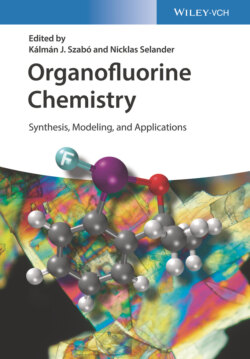Читать книгу Organofluorine Chemistry - Группа авторов - Страница 6
Preface
ОглавлениеFluorine is the 13th most abundant element in the Earth's crust (the most abundant halogen), yet only a couple of biologically produced natural organofluorine compounds are known. Fluorine has the highest electronegativity of the elements – generating a number of specific problems in the synthesis (and biosynthesis) of organofluorine compounds. The majority of fluorine is present in its reduced form, mainly as the fluoride ion (F−). This leads to at least two problems when creating C—F bonds: the very high heat of hydration of the fluoride ion (F−), which makes it a very poor nucleophile; and the very high oxidation potential of fluorine which makes synthesis and handling of (highly reactive) electrophilic fluorination reagents usually difficult. The upside of the lack of efficient biosynthetic pathways to C—F bonds is that organofluorines have very useful pharmacological and pharmacokinetic properties, such as high metabolic stability against enzymatic oxidation. The C—F bonds usually increase the lipophilicity and modify the acid‐base properties of pharmacophores. In addition, the C—F bond is the strongest single bond that a carbon atom can form with another element. These beneficial properties substantially increase the bioavailability of small molecules, which allows the use of fluorinated drugs and agrochemicals in lower doses than their non‐fluorinated counterparts, ensuring optimal bioactivity with a lower environmental impact for these types of chemicals.
As mentioned above, all useful organofluorine compounds are human made. Therefore, there is an enormous pressure on synthetic organic chemists to produce a wide variety of new fluorinated compounds. This book is intended to cover the most important state‐of‐the‐art synthetic methods and addresses current challenges within the field. At the same time, it gives in‐depth analysis of the underlying chemical processes controlling the formation of new bonds between carbon and fluorine or fluorinated functional groups. A further important aspect is the application of organofluorine compounds in various areas of medicinal and agrochemistry.
This book has a very strong emphasis on the classification, application, and properties of various modern fluorinating reagents. The most important requirement for these reagents is the possibility to use them under mild conditions for selective transformations. Another important aspect is the safe and operationally simple handling of the fluorine transfer reagents. Accordingly, the first chapter by Jianbo Hu and coworkers analyzes the basic aspects of the fluorine effects in organic transformation with special emphasis on the introduction of difluoro‐ and trifluoromethyl groups. In Chapter 2 Sodeoka and coworker review the trifluoromethylation and fluoroalkylation reactions using selective, inexpensive reagents. Functional groups with OCF3, SCF3 and SeCF3 and related structures are very important in organofluorines targeted in medicinal‐ and agrochemical applications. Introduction of these functional groups is reviewed in Chapter 3 by Billard and coworkers. A broad review about the development, synthesis and application of SCF3 transfer reagents is given by Shen and coworkers in Chapter 4. The substrate scope of the fluorination and fluoroalkylation reactions is also discussed in detail. In Chapter 5 Liu and coworkers summarize the fluorination‐ and trifluoromethylation‐based difunctionalization reactions. Chapter 6 by Szabó is focused on different substrate classes including alkenes, cyclopropanes, and diazo compounds in fluorination, trifluoromethylation, and trifluoromethylthiolation reactions. Modern methodology, such as photoredox catalysis, is an important tool even in fluorination reactions. This topic is summarized in Chapter 7 by Akita and coworkers. Control of stereochemistry to obtain enantiopure organofluorines is one of the most important requirements in medicinal applications. Toste and coworker summarized the most important development in asymmetric fluorination in Chapter 8. Chiral organofluorine compounds have some extraordinary properties, such as the ability for self‐disproportionation of enantiomers (SDE), which can be exploited for purification. Klika and coworkers described this phenomenon in Chapter 9. Mechanistic and modeling studies are presented in many of the above chapters. In Chapter 10 by Xue and coworkers, DFT modeling studies on the special mechanistic features for the introduction of fluorine and fluoroalkyl groups are summarized with a particular focus on the catalytic reactions and application of the new fluorinating reagents. As mentioned above, application of organofluorines is particularly important in chemical industry. A large part of the commercially applied agrochemicals introduced in the last decade are fluorinated compounds. In Chapter 11 by Jeschke, the modern trends in design of fluorine‐containing compounds are described analyzing the most important classes of herbicides, fungicides, and insecticides. Fluorine‐18 labeling of positron emission tomography (PET) tracers is one of the most challenging areas in organofluorine chemistry. Application of new methodology and reagents is reviewed in Chapter 12 by Liang and coworkers.
This book is a result of a global collaboration by excellent research groups from Asia, Europe, and North America indicating worldwide efforts of the organofluorine community to forward this field, which is very important in synthetic and mechanistic research as well as in industrial applications. We would like to appreciate all authors of this book for their enthusiasm and for sharing their knowledge in organofluorine chemistry with the readers and their help in the realization of this book. In addition, the editors are indebted to the Knut och Alice Wallenbergs Foundation for granting the project “Organofluorines: anthropogenic small‐molecules for life sciences” (Dnr: 2018.0066).
Stockholm, April 2020
Kálmán J. Szabó
Stockholm University, Arrhenius Laboratory
Department of Organic Chemistry
Stockholm, Sweden
